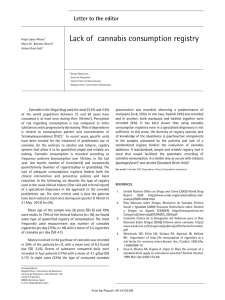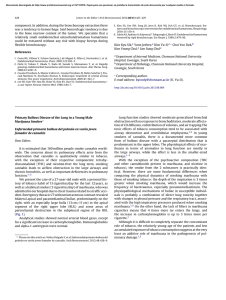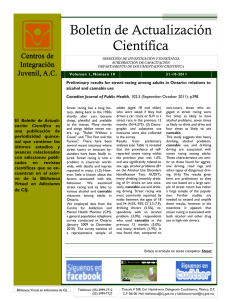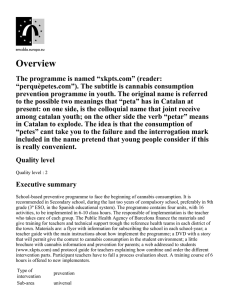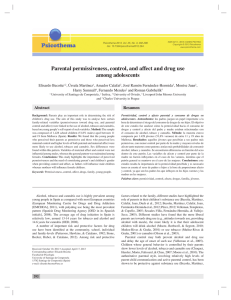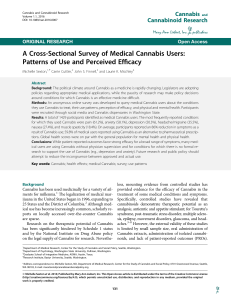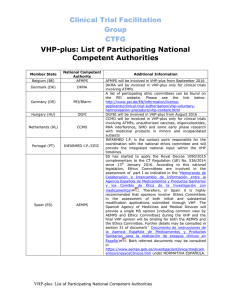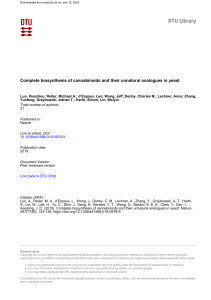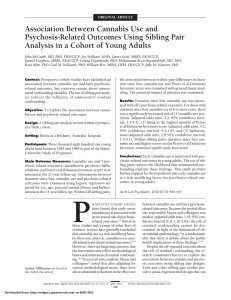View PDF - Psicothema
Anuncio
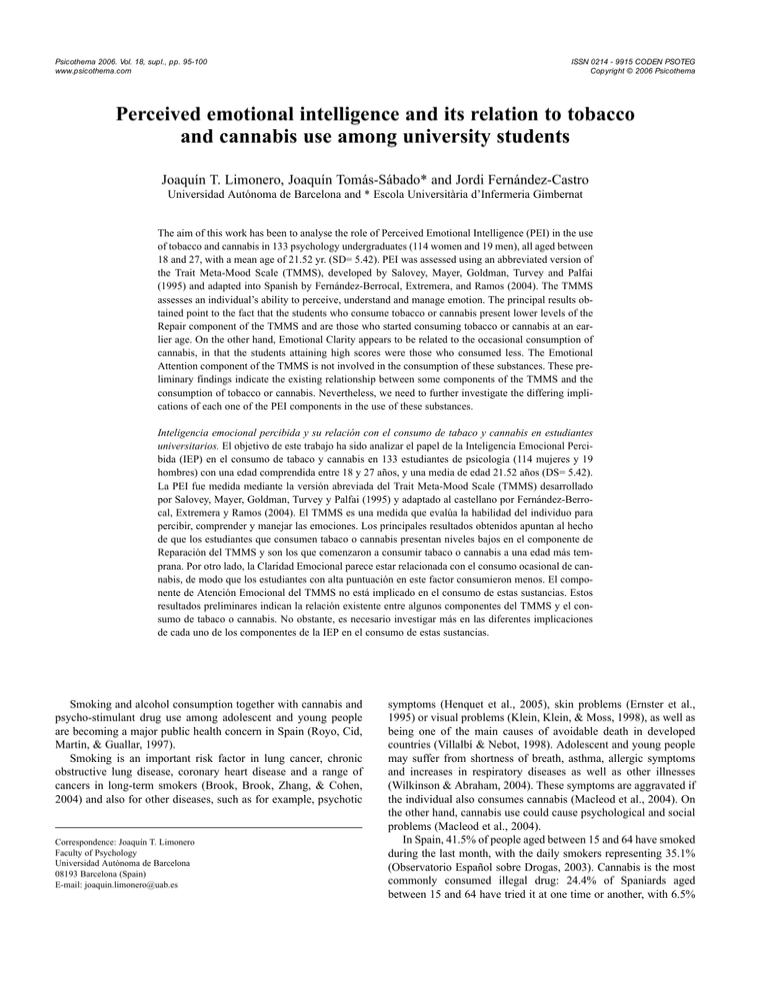
Psicothema 2006. Vol. 18, supl., pp. 95-100 www.psicothema.com ISSN 0214 - 9915 CODEN PSOTEG Copyright © 2006 Psicothema Perceived emotional intelligence and its relation to tobacco and cannabis use among university students Joaquín T. Limonero, Joaquín Tomás-Sábado* and Jordi Fernández-Castro Universidad Autónoma de Barcelona and * Escola Universitària d’Infermeria Gimbernat The aim of this work has been to analyse the role of Perceived Emotional Intelligence (PEI) in the use of tobacco and cannabis in 133 psychology undergraduates (114 women and 19 men), all aged between 18 and 27, with a mean age of 21.52 yr. (SD= 5.42). PEI was assessed using an abbreviated version of the Trait Meta-Mood Scale (TMMS), developed by Salovey, Mayer, Goldman, Turvey and Palfai (1995) and adapted into Spanish by Fernández-Berrocal, Extremera, and Ramos (2004). The TMMS assesses an individual’s ability to perceive, understand and manage emotion. The principal results obtained point to the fact that the students who consume tobacco or cannabis present lower levels of the Repair component of the TMMS and are those who started consuming tobacco or cannabis at an earlier age. On the other hand, Emotional Clarity appears to be related to the occasional consumption of cannabis, in that the students attaining high scores were those who consumed less. The Emotional Attention component of the TMMS is not involved in the consumption of these substances. These preliminary findings indicate the existing relationship between some components of the TMMS and the consumption of tobacco or cannabis. Nevertheless, we need to further investigate the differing implications of each one of the PEI components in the use of these substances. Inteligencia emocional percibida y su relación con el consumo de tabaco y cannabis en estudiantes universitarios. El objetivo de este trabajo ha sido analizar el papel de la Inteligencia Emocional Percibida (IEP) en el consumo de tabaco y cannabis en 133 estudiantes de psicología (114 mujeres y 19 hombres) con una edad comprendida entre 18 y 27 años, y una media de edad 21.52 años (DS= 5.42). La PEI fue medida mediante la versión abreviada del Trait Meta-Mood Scale (TMMS) desarrollado por Salovey, Mayer, Goldman, Turvey y Palfai (1995) y adaptado al castellano por Fernández-Berrocal, Extremera y Ramos (2004). El TMMS es una medida que evalúa la habilidad del individuo para percibir, comprender y manejar las emociones. Los principales resultados obtenidos apuntan al hecho de que los estudiantes que consumen tabaco o cannabis presentan niveles bajos en el componente de Reparación del TMMS y son los que comenzaron a consumir tabaco o cannabis a una edad más temprana. Por otro lado, la Claridad Emocional parece estar relacionada con el consumo ocasional de cannabis, de modo que los estudiantes con alta puntuación en este factor consumieron menos. El componente de Atención Emocional del TMMS no está implicado en el consumo de estas sustancias. Estos resultados preliminares indican la relación existente entre algunos componentes del TMMS y el consumo de tabaco o cannabis. No obstante, es necesario investigar más en las diferentes implicaciones de cada uno de los componentes de la IEP en el consumo de estas sustancias. Smoking and alcohol consumption together with cannabis and psycho-stimulant drug use among adolescent and young people are becoming a major public health concern in Spain (Royo, Cid, Martín, & Guallar, 1997). Smoking is an important risk factor in lung cancer, chronic obstructive lung disease, coronary heart disease and a range of cancers in long-term smokers (Brook, Brook, Zhang, & Cohen, 2004) and also for other diseases, such as for example, psychotic Correspondence: Joaquín T. Limonero Faculty of Psychology Universidad Autónoma de Barcelona 08193 Barcelona (Spain) E-mail: joaquin.limonero@uab.es symptoms (Henquet et al., 2005), skin problems (Ernster et al., 1995) or visual problems (Klein, Klein, & Moss, 1998), as well as being one of the main causes of avoidable death in developed countries (Villalbí & Nebot, 1998). Adolescent and young people may suffer from shortness of breath, asthma, allergic symptoms and increases in respiratory diseases as well as other illnesses (Wilkinson & Abraham, 2004). These symptoms are aggravated if the individual also consumes cannabis (Macleod et al., 2004). On the other hand, cannabis use could cause psychological and social problems (Macleod et al., 2004). In Spain, 41.5% of people aged between 15 and 64 have smoked during the last month, with the daily smokers representing 35.1% (Observatorio Español sobre Drogas, 2003). Cannabis is the most commonly consumed illegal drug: 24.4% of Spaniards aged between 15 and 64 have tried it at one time or another, with 6.5% 96 JOAQUÍN T. LIMONERO, JOAQUÍN TOMÁS-SÁBADO AND JORDI FERNÁNDEZ-CASTRO of them being monthly consumers. As regards teenagers (ages 1519), the rates of tobacco and cannabis uses are, respectively, 25% for tobacco smoked daily and 12.2% for cannabis consumption in the last month. Smoking habits usually begin in adolescence. Most adolescent smokers are regular tobacco users or are close to becoming so as their consumption has continued to grow (Wilkinson & Abraham, 2004). The percent of initial experimenters who became regular smokers by the end of this period is around of 20% (Tucker, Ellickson, & Klein, 2003). In order to improve prevention programmes, a heightened awareness of smoking initiation and maintenance is called for. Bearing in mind the arguments put forward together with the health, social, economic and political ramifications involved, the efforts made in this field by the various administrations and governments to gain a better understanding of the phenomenon of drug addiction in young people, so as to help prevent it and bring about a conscious adult population, are wholly justified. There are been several trials to apply general health behavior theories into smoking behavior prediction, for example, the Theory of Reasoned Action (Ajzen, Timko, & White, 1982; Norman & Tedeshi, 1989) and the Theory of Planed Behavior (Higgins & Conner, 2003; Spijkerman, Eijnden, Vitale, & Engels, 2004), obtaining dissimilar findings. Recently, the concept of Emotional Intelligence appears like a new theory that tries to explain the human behaviour in several situations (Goleman, 1995). Mayer and Salovey (1997) define emotional intelligence (EI) as the ability to accurately perceive, appraise and express emotion; to understand emotion and emotional knowledge regulate emotions and access or generate feeling in facilitating thought. The EI defined by these authors is characterised by a series of skills that encompass the following processes: a) perception, appraisal and expression of emotion, which involves an identification of both one’s own emotions and those of others, as well as the ability to express them; b) understanding and analysis of emotions, which allows one to label them and understand the relationships between them, as well as the situation that has given rise to them and c) control of emotions; an ability to regulate or control one’s own emotions (positive and negative) and that of others. In this sense, the current research on EI tries to analyze the value and the utility of the EI in diverse areas of the person. So for example, EI appears to be an important predictor of success in life, such as in coping strategies (Limonero, Tomás-Sábado, FernándezCastro, & Gómez-Benito, 2004), life satisfaction (Martínez Pons, 1997), quality of life (Extremera & Fernández-Berrocal, 2002), depression (Rodríguez & Romero, 2003), leadership (Cadman & Brewer, 2001), academic achievement (Brackett, Mayer, & Warner, 2004), and interpersonal relations (Schutte et al., 2001). The aim of the present study is to explore the association between self-reported EI and tobacco and cannabis use amongst young university students, from the Mayer and Salovey’s standpoint (1997). EI abilities will not be explored itself, but the spotlight will be on reflective mood experience, which Salovey, Woolery and Mayer (2001) have termed perceived emotional intelligence (PEI), that is, people’s beliefs about their own emotional intelligence. PEI has been chosen as key factor because this perception of efficacy on emotional self-control could be related to the election of other resources of emotional control as illegal or legal drugs in the case adolescents have a low PEI. For own best knowledge, there are not studies on the relationship between EI and cannabis use and only three studies about the relationship between EI and tobacco use. (Trinidad & Johnson, 2002; Trinidad, Unger, Chou, & Johnson, 2004; Trinidad, Unger, Chous, Azen, & Johnson, 2004). So for example, Trinidad and Johnson (2002) in a pioneering research found in 205 multi-ethnic Californian adolescents that the overall score of EI, measured by abbreviated version of the Multifactor Emotional Intelligence Scale (MEIS), show a significant association with, general alcohol and tobacco use. Likewise, the Emotional Attention and the Clarity emotion branch were negatively correlated with general tobacco use. No correlation was found between Repair emotion branch and tobacco use. In the same line, Trinidad et al., (2004a) found in 416 American adolescents from middle schools from Los Angeles that high EI has a protective association with psychosocial risk factors for smoking. High EI was related to an increased perception of the negative social consequences on smoking, an increased perceived ability to refuse a cigarette offer, as well as lower likehood of intending to smoke in the future (next year). Trinidad et al., (2004b) analyzed in the same sample that the previous work that those adolescents with high EI are more likely to intend to smoke if they are previously experimented with cigarettes, whereas those with low EI are more likely to intend to smoke if they are more hostile or have a low perceived ability to refuse a cigarette offer from a peer. Nevertheless, these authors conclude that further research is needed in order to validate these findings and to analyse in more detail the bearing that different components of EI have on tobacco use in adolescents. Concretely, the purpose of this work is to examine the role of the different components of Perceived Emotional Intelligence on smoking tobacco and cannabis use amongst Spanish university students since there is an important lack of published literature about this topic, especially on illegal drug. We will attempt to verify that (1) students with high levels of the Clarity and Repair components of PEI will consume less tobacco and cannabis; whilst (2) those with high levels of the Attention component of PEI will smoke more tobacco and cannabis. Method Subjects Participants were 133 psychology undergraduates, 114 women and 19 men, from the Universitat Autònoma de Barcelona (UAB), Spain. Ages ranged from 18 to 27, with a mean of 21.52 yr. (SD= 5.42). All participants took part voluntarily and remained strictly anonymous. Instruments The following three self-report questionnaires were administrated to all participants in the present study: • In order to evaluate the Perceived Emotional Intelligence, we used the TMMS-24, being a scale based on the Trait Meta-Mood Scale (TMMS) of the Salovey et al. (1995) research group and adapted to Spanish by FernándezBerrocal, Extremera and Ramos (2004). The TMMS-24 is a scale that contains three dimensions of PEI with 8 items within each one: emotional Attention, emotional Clarity (or PERCEIVED EMOTIONAL INTELLIGENCE AND ITS RELATION TO TOBACCO AND CANNABIS USE AMONG UNIVERSITY STUDENTS Understanding) and emotional Repair. This scale evaluates the effects of the beliefs or perceptions of the subjects on their ability to be attentive to emotions, to understand them and to control or regulate them. Attention conveys the degree to which individuals tend to observe and think about their feeling and moods; Clarity evaluates the tendency to discriminate among moods or emotions, and Repair refers to subject’s tendency to regulate or modulate their feelings. The 24 items that make up the scale have a Likert-based format of answering with five options that range from: never, rarely, sometimes, quite often and very often. This scale is analysed with regard to the sum of the scores obtained in each one of the three subscales or dimensions of PEI, and not in terms of the overall score from the scale. • In order to evaluate drug intake and related behaviour, we have used a reduced and modified version of the survey drawn up by the Plan Nacional Sobre Drogas (2003), of the Spanish Home Office and the work of Limonero, Plaza, Cuenca, Riera and Fernández-Castro (2002). • Risk perception. By means of a scale comprised of 6 items, with a Likert-based format of answering —with five options that range from no risk to very high risk— we evaluate the risk that the regular consumption of tobacco and cannabis would pose to one’s health, regardless of one’s current intake, as well as the estimated risk of certain negative events occurring whilst under the effects of cannabis. Procedure The questionnaire was administered collectively in different classrooms of the Psychology Department of the UAB, ensuring at all times the strict confidentiality and anonymity of the information and making it quite clear that such data would solely be treated for statistical ends. The time required to complete the questionnaire was approximately 20 minutes. Results As regards the different components of PEI, the average values obtained varied from 27.13 points of the Repair component to 31.21 of the Attention component (table 1). The reliability analyses carried out showed us that the internal consistency of each one of the subscales making up PEI, through the use of Cronbach’s alpha coefficient, ranged from 0.84 for the Repair component to 0.90 for the Attention component; the Clarity component obtained a value somewhere between the two, namely of 0.86. The Friedman test (X2= 31.49; p<0.01) revealed statistically significant variances in terms of the scores obtained in Table 1 Means, standard deviations and percentiles of sub-scales of the Trait Meta Mood Scale -TMMS-24 97 each one of the components of the PEI scale. No statistically significant differences were observed in terms of the gender variable in any of the three components of the PEI: Attention (X2= 0.125; gl.= 1; p= 0.723); Clarity ((X2= 0.565; gl.= 1; p= 0.452); and Repair (X2= 0,1202; gl.= 1; p= 0.750). Students that have smoked at some point (82%) show no differences in any of the three components of PEI to those who haven’t (18%): Attention (K-W= 0.093; gl= 1; p= 0.761); Clarity (K-W= 0.015; gl= 1; p= 0.903) and Repair (K-W= 0.858; gl= 1; p= 0.354). Using the values of quartiles 1 and 3 (see table 1) of the overall score of each one of the different components of PEI, we have divided the subjects in each of these dimensions into two groups: high and low. In this regard, the students that obtained lower scores in the repair component of PEI are those that have smoked earlier (K-W= 3.79; gl= 1, P= 0.05). In other words, they tried tobacco at an earlier age. In addition, those achieving the high scores in this component smoke less than those with low levels (X2= 3.95; gl= 1; p= 0.047). If we compare the subjects that smoke on a daily basis, it becomes apparent that those that smoke more cigarettes are those which scored lower in the Clarity component of PEI (K-W= 4,49; gl= 1; p= 0,34). Likewise, the amount of cigarettes smoked daily has a negative correlation with the Clarity component of PEI (r= -0.31; p<0.05). Table 2 contains the averages and typical deviations of the three components of EI for smokers and non-smokers alike, as well as the t values and significance of such differences. We can observe that the smokers, in contrast to their non-smoking colleagues, display better scores in the Repair component of EI (t= -2.26; gl= 130; p= 0.03). There were no significant differences as among the other two components of EI: Attention (t= -0.10, gl= 130; p= 0.92) and Clarity (t= -0.40; gl= 130; p= 0.69). As regards the consumption of cannabis, we can see that there are no statistically significant differences in relation to the different components of PEI amongst the students that have smoked cannabis at some point and those that have never tried it: Emotional Attention (t= 0.489; gl= 130; p= 0.625); Emotional Clarity (t= -0.535; gl= 130; p= 0.593) and Emotional Repair (t= 0.626; gl= 130; p= 0.532). As is the case with tobacco, the students that attained lower scores in the Repair component of PEI are those that have smoked cannabis at an earlier age (K-W= 6.5; gl= 1, P= 0.011). The students that smoke cannabis on a regular basis (daily or weekly) score lower in the emotional Repair component (X2= 3.86; gl= 1; p= 0.049) of PEI than those that don’t smoke, with no notable difference in emotional Attention (X2= 0.024; gl= 1; p= 0.087) and Clarity (X2= 0.012; gl= 1; P= 0.091) of PEI (table 3). Table 2 Averages, typical deviations, t values and the significance of the differences in the scores of tobacco smokers and non-smokers for the three components of Perceived Emotional Intelligence Attention Clarity Repair Mean 31.21 29.80 27.13 St. Dv. 05.08 04.44 05.17 Percentile 25 28.00 27.00 23.00 Attention 31.26 (5.32) 31.17 (4.92) -0.10 0.92 -1.86, 1.68 Percentile 50 31.00 30.00 27.00 Clarity 29.98 (4.59) 29.67 (4.34) -0.40 0.69 -1.86, 1.23 Percentile 75 35.00 32.00 31.00 Repair 26.25 (4.71) 28.28 (5.56) -2.26 0.03 -3.84, -0.21 Average smokers (SD) Average nonsmokers (SD) t Significance (p) Interval 95% 98 JOAQUÍN T. LIMONERO, JOAQUÍN TOMÁS-SÁBADO AND JORDI FERNÁNDEZ-CASTRO Likewise, the Repair component has a negative correlation (Rho= -0.542; p= 0.005) with the number of times that cannabis is smoked weekly, with higher consumption leading to lower scores in this component. The subsequent regression analysis established that the emotional Repair component of PEI explains 29% of the variance of the number of times that cannabis has been consumed (F= 9.57; p= 0.005). On the other hand, if we compare sporadic cannabis smokers with the non-smokers, we can see that those which consume cannabis attain lower scores in the emotional Clarity of PEI (t= 1.98; gl= 109; p= 0.05), there being no observable differences between the regular cannabis smokers and occasional cannabis smokers in any of the three components of PEI. As for the perceived health risks of regularly consuming tobacco or cannabis, we noted that the students consider smoking cigarettes to be more detrimental than smoking cannabis (X2.= 39.47; g.l.= 1; p= 0.001), with 62.4% of the students believing that the health risk is high in the case of tobacco, whilst cannabis was considered so by 54.6%. Likewise, the students achieving higher scores in the Clarity component of PEI placed a higher value on the health risk of cannabis smoking than those that scored lower (t= -2.095; g.l.= 74; p= 0.039). There were no observable differences as regards the other components of PEI in relation to the consumption of cannabis or tobacco. Discussion In this study, we have analysed the existing relationship between perceived emotional intelligence (PEI), defined as the perceived ability to attend to, distinguish among and regulate moods and the consumption of tobacco and cannabis in first year university students. Using the information obtained, we can observe that in the vast majority of the university student study group, more than 80% have smoked a cigarette at some point and more than 70% have consumed cannabis at one time or another. Likewise, more than 39% smoked on daily basis and 16% consumed cannabis regularly. This data on the initial contact with tobacco and with cannabis is similar to those present both in the same age group of the general public (Observatorio Español sobre Drogas, 2003) as well as in young people from other European countries (Karatzias, Power, & Swanson, 2001). The apparent prevalence of cigarette smoking is also similar to that observed in the same age group of the general public. Nevertheless, the prevalence of cannabis smokers is slightly higher. All this indicates that, despite the enormous pressure the health authorities are putting on tobacco and cannabis use, the consumption of these drugs is widely and generally accepted in society (Anonymous, 2004; Rodríguez de Paz, 2004), particularly amongst university students. It can come Table 3 Averages, typical deviations, X2 values and the significance of the differences in the scores of cannabis smokers and non-smokers for the three components of Perceived Emotional Intelligence Average smokers (SD) Average nonsmokers (SD) X2 Significance (p) Attention 30.76 (5.02) 31.06 (5.25) 0.024 0.087 Clarity 29.66 (3.61) 30.50 (4.95) 0.012 0.091 Repair 26.40 (5.19) 28.85 (5.13) 3.868 0.049 as no surprise that this degree of consumption has already become a major problem in European countries (Watson, 2004). The average ages at which cigarettes are smoked for the first time and at which it becomes a regular habit are younger than the average ages at which cannabis is tried for the first time and at which it is consumed on a regular basis. In the case of tobacco, the first cigarette is smoked at the age of approximately 14, with this becoming regular two years from this point, at around 16, whilst cannabis use is generally initiated at the age of 16.5, with its regular consumption occurring half a year later, at approximately 17. Whereas this data on tobacco smoking is similar to that recorded in the general public, the figures on cannabis use are not, as the group under investigation started consuming a year earlier (Observatorio Español sobre Drogas, 2003). It is worth pointing out that almost all the cannabis smokers of our study were cigarette smokers (96.6%), there being a clear relationship between the consumption of both substances. Nevertheless, it is necessary to analyse this relationship in greater detail, given the wide range of factors that may play a part their consumption (Calleja, García-Señorán, & González, 1996; Charol, Ducongé, Casas, Roura, & Carcy, in press). If we analyse the relationship of PEI with the commencement of tobacco or cannabis consumption, we can detect no significant differences in any of the three PEI components between the students that have smoked before or have tried cannabis and those that haven’t. Nevertheless, a more detailed analysis of the role of the PEI components has revealed to us that those students presenting low values in the emotional Repair component of PEI are those that have smoked either tobacco or cannabis earlier in the past; in other words, they consumed these substances at a younger age. They are also those that smoke a greater amount of tobacco or cannabis cigarettes. Likewise, as regards the regular consumption of tobacco or cannabis, we noted that the students that consume these substances also display lower values in the emotional Repair component of PEI than those that don’t smoke either of them. As pointed out by Salovey (2001) and Gross (2001), this data highlights the importance of having a good ability to understand and repair negative emotions, as well as an ability to keep up or prolong positive emotions over a longer period of time. In this respect, those students less able to repair their emotional state would be more tempted to start smoking tobacco and/or cannabis. In addition, regular consumption of such substances would help, at least in part, to alleviate this emotional deficit. In fact, personal skills are a key element in being able to adapt to the demands of one’s environment and would be a protective factor in helping to counter drug use in adolescence and youth (Griffin, Botvin, Scheier, Epstein, & Doyle, 2002; Griffin, Scheier, Botvin, & Díaz, 2001). Indeed, Trinidad et al., (2004a) have observed that EI in American schools, measured globally through the use of the MEIS scale, interacts with risk factors to reduce smoking intentions. The students that smoke cannabis occasionally score lower in the emotional Clarity component of PEI than those that don’t consume cannabis, meaning that those young individuals that attain higher scores in the emotional Clarity component and are therefore able to clearly understand the emotions they are experiencing as well as the situations that have given rise to them, would consume less of this drug. In fact, emotional Clarity is a key factor in the success of interpersonal relationships, as suggested by Schutte et al., (2001), and would be partly related to empathy, social skills, assertiveness or one’s self-efficacy in resisting (Trinidad et al., 2004a). PERCEIVED EMOTIONAL INTELLIGENCE AND ITS RELATION TO TOBACCO AND CANNABIS USE AMONG UNIVERSITY STUDENTS Paradoxically, the study revealed that the students consider the regular use of tobacco to be more detrimental to health than the consumption of cannabis, highlighting the clear social acceptance of this drug by a large proportion of young people (Rodríguez de Paz, 2004; Royo et al., 1997). Likewise, those students that scored higher in the emotional Clarity component of PEI would be those that placed a higher value on the negative repercussions such consumption would pose for one’s health. Along these lines, Trinidad et al. (2004a) studied American adolescents aged between 10 and 13 and observed that high overall levels of emotional intelligence, measured through the use of the MEIS scale, are linked to a heightened perception of the negative consequences of tobacco. In keeping with these findings, the students consider the risk of suffering from certain undesirable consequences under the effects of cannabis to be moderate, with a failure to perform well either academically or at work being the greatest negative effect. Once again, the emotional Clarity factor split the students as regards their perception of the risk of suffering some undesirable effect due to cannabis consumption, such as the loss of self-control, which was valued as being more likely by those that obtained a higher score in this component. As can be deduced from the analysed data, our hypotheses or predictions have been confirmed in part; whereas both the Clarity and the Repair components of PEI are related, to a greater or lesser extent, to the commencement of tobacco or cannabis use and their continued use (hypothesis 1), the effect of the emotional Attention factor on consumption (hypothesis 2) has not been confirmed. In other related studies, such as death anxiety (Limonero, TomásSábado, Gómez-Romero, Sanz, & Aradilla, 2004), expressed emotion (Sallent, 2004), stress at work (Limonero et al., 2004) or the quality of life perceived by middle-age women (Extremera & Fernández-Berrocal, 2002), this differential behaviour of the various factors that make up PEI has also been observed. In our opinion, what is called for are further investigations and a closer look at the subject so as to determine and clarify the differing implications of each one of the EI components in the commencement and continued use of tobacco and cannabis amongst young people. We would point out however that there is a lack of investigations in this field. Indeed, the limited amount of current studies of which we are aware are carried out by Trinity’s group at the University of California (Trinidad & Johnson, 2002; Trinidad et al., 2004a; Trinidad et al., 2004b), in which such authors have analysed the overall relationship between EI and 99 alcohol and tobacco consumption in adolescents. We do not know the existence of any work that analyze the relation between EI and cannabis use. The information on the high prevalence of tobacco and cannabis consumption points to the high percentage of students that have consumed these substances at ages as early as adolescence and highlights the need for initiatives aimed at preventing the initial contact with these substances and their subsequent continued use (Gómez, Luengo, & Romero, 2002; Sánchez, 2000) at this critical stage in one’s life cycle, when vulnerability to drugs is greater and the perception of the risk of suffering negative consequences due to their use is very low (Halpen, Bichl, Krop, & Rubistein, 2004). This could be achieved, for example, through training programmes dealing with how to handle one’s own emotions. Such programmes would, we believe, have to be related to the different components of PEI, which have been shown to be involved in drug use; for example, by strengthening the use of techniques to repair and understand emotions and by restructuring our perception of the highly stressful factors that surround us, represented above all by peer group pressure, as well through the use of other techniques based on strengthening social skills, assertiveness techniques and educational health programmes, we could achieve more adaptive behaviour and help to make these personal skills improve one’s own resistance to tobacco or cannabis consumption. Nevertheless, we are aware that drug use is a complex and multifaceted problem (Calleja et al., 1996). In this sense, we believe that EI would act as an independent variable that could have a bearing on other variables leading to drug use and the process of addiction. A limitation of this study is that the uneven proportions of women and men in our sample may have obscured the relationship between tobacco and cannabis use and gender and PEI. Further studies need to be performed in order to validate the findings of this research and further analyses conducted to better understand the role of different components of PEI on tobacco smoking and cannabis use in young people; knowledge that can be used to develop improved adolescent and youth drug prevention programs. Acknowledgements This work by supported, in part, by Grants BSO2002-01123 of DGICYT of the Science and Technology Ministry of Spain and by grant 2002SGR 00153 from the Generalitat of Catalunya, Spain. References Anonymous (June 27, 2004). El consumo de cocaína y cannabis aumenta entre los jóvenes catalanes. La Vanguardia, 32. Ajzen, I., Timko, C., & White, J.B. (1982). Self-monitoring and the attitude-behavior relation. Journal of Personality and Social Psyhcology, 42, 426-435. Brackett, M.A., Mayer, J.D., & Warner, R.M. (2004). Emotional intelligence and its relation to everday behavior. Personality and Individual Differences, 36, 1387-1402. Brook, J.S., Brook, D.W., Zhang, C., & Cohen, P. (2004). Tobacco use and health in young adulthood. The Journal of Genetic Psychology, 165, 310-323. Cadman, C. & Brewer, J. (2001). Emotional intelligence: a vital prerequisite for recruitment in nursing. Journal of Nursing Management, 9, 321-324. Calleja, J.A., García-Señorán, M.M., & González, S.G. (1996). Consumo de drogas en la adolescencia. Psicothema, 8, 257-267. Charol, H., Ducongé, E., Casas, C., Roura, C., & Carcy, K.B. (in press). Relations between cannabis use and dependence, motives for cannabis use and anxious, depressive and borderline symptomatology. Addictive Behavior. Ernster, V.L., Grady, D., Mulke, R., Black, D., Selby, J., & Kerlikowske, K. (1995). Facial wrinklin in men and women by smoking status. American Journal of Public Health, 85, 78-82. Extremera, N. & Fernández-Berrocal, P. (2002). Relation of perceived emotional intelligence and health-related quality of life of middle-aged women. Psychological Reports, 91, 47-59. Fernández-Berrocal, P., Extremera, N., & Ramos, N. (2004). Validity and reliability of the Spanish version of the Trait Meta-mood Scale. Psychological Reports, 94, 751-755. 100 JOAQUÍN T. LIMONERO, JOAQUÍN TOMÁS-SÁBADO AND JORDI FERNÁNDEZ-CASTRO Goleman, D. (1995). Emotional intelligence. New York: Bantam Books. Gómez, J.A., Luengo, A., & Romero, E. (2002). Prevención del consumo de drogas en la escuela: cuatro años de seguimiento de un programa. Psicothema, 14, 685-692. Griffin, K.W., Botvin, G.J., Scheier, L.M., Epstein, J.A., & Doyle, M.M. (2002). Personal competence skills, distress and well-being as determinants of substance use in a predominantly minority urban adolescent sample. Prevention Science, 3, 23-29. Griffin, K.W., Scheier, L.M., Botvin, G.J., & Díaz, T. (2001). Protective role of personal competence skills in adolescent substance use: psychological well-being as a mediating factor. Psychology and Addictive Behaviors, 15, 194-203. Gross, J.J. (2001). Emotional regulation in adulthood: timing is everything. Current Direction in Psychosocial Science, 10, 214-219. Halpen, B.L., Bichl, M., Krop, R.Y., & Rubistein, M.L. (2004). Perceived risk and benefits of smoking differences among adolescents with different smoking experiences and intentions. Preventive Medicine, 39, 559567. Henquet, C., Krabbendam, L., Spauwen, J., Kaplan, C., Lieb, R., Wittchen, H.U., & Van Os, J. (2005). Prospective cohort study of cannabis use, predisposition for psychosis and psychotic symptoms in young people. British Medical Journal, 330, 11. Higgins, A. & Conner, M. (2003). Understanding adolescent smoking: the role of the theory of planned behavior and implementation intentions. Psychology, Health and Medicine, 8(2), 173-186. Karatzias, A., Power, K.G., & Swanson, V. (2001). Predicting use and maintenance of use of substances in Scottish adolescents. Journal of Youth and Adolescents, 30, 465-484. Klein, R., Klein, B.E., & Moss, S.P. (1998). Relation of smoking to the incidence of age-related maculopaty: the beaver dam eye study. American Journal of Epidemiology, 147, 103-110. Limonero, J.T., Plaza, I., Cuenca, A., Riera, E., & Fernández-Castro, J. (2002). Relación entre la inteligencia emocional y el consumo de drogas. Paper presented at the IV Congreso Internacional de la Sociedad Española para el Estudio de la Ansiedad y el Estrés, Benidorm. Limonero, J.T., Tomás-Sábado, J., Fernández-Castro, J., & Gómez-Benito, J. (2004). Influencia de la inteligencia emocional percibida en el estrés laboral de enfermería. Ansiedad y Estrés, 10, 29-41. Limonero, J.T., Tomás-Sábado, J., Gómez-Romero, M.J., Sanz, A., & Aradilla, A. (2004). Relación entre inteligencia emocional percibida, optimismo y ansiedad ante la muerte. Paper presented at the VII European Conference of Psychological Assessment, Málaga. Macleod, J., Oakes, R., Copello, A., Crome, I., Egger, M., Hickman, M., Oppenkowski, T., Stokes-Lampard, H., & Smith, G.D. (2004). Psychological and social sequelae of cannabis and other illicit drug use by young people: a systematic review of longitudinal, general population studies. Lancet, 363, 1579-1588. Martínez Pons, M. (1997). The relation of emotional intelligence with selected areas of personal functioning. Imagination, Cognition and Personality, 17, 3-13. Mayer, J.D. & Salovey, P. (1997). What is emotional intelligence? In P. Salovey and D. Sluyter (eds.): Emotional development and emotional intelligence: implications for educators (pp. 3-31). New York: Basic Books. Norman, N.M. & Tedeshi, J.T. (1989). Self-representation, reasoned action and adolescents’ decisions to smoke cigarettes. Journal of Applied Social Psychology, 19, 543-558. Observatorio Español sobre Drogas (2003). Informe núm. 6 Observatorio Español sobre Drogas. Madrid: DGPNSD, Ministerio del Interior. Rodríguez, C. & Romero, E. (2003). La inteligencia emocional, ¿factor de protección antidepresivo? Encuentros de Psicología Social, 1, 295298. Rodríguez de Paz, A. (November 26, 2004). Más de un tercio de los jóvenes españoles reconocen que han probado el cannabis. La Vanguardia. Royo, M.A., Cid, J., Martín, J.M., & Guallar, E. (1997). Drug and alcohol use in Spain: consumption habits, attitudes and opinions. Public Health, 111, 277-284. Salovey, P. (2001). Applied emotional intelligence: regulating emotions to become healthy, wealthy and wise. In J. Ciarrochi, J.P. Forgas and J.D. Mayer (eds.): Emotional intelligence and everyday life (pp. 168-184). New York: Psychological Press. Salovey, P., Mayer, J.D., Goldman, S.L., Turvey, C., & Palfai, T.P. (1995). Emotional attention, clarity and repair: exploring emotional intelligence using the Trait Meta-mood Scale. In J.W. Pennebaker (ed.): Emotion, disclosure and health (pp. 125-151). Washington, DC: American Psychological Association. Salovey, P., Woolery, A., & Mayer, J.D. (2001). Emotional intelligence: conceptualization and measurement. In G.J.O. Fletcher and M.S. Clark (eds.): Handbook of social psychology: interpersonal processes (pp. 279-307). Malden, MA: Blackwell. Sallent, V. (2004). Intel·ligencia emocional percebuda i emoció expressada en cuidadors de pacients amb esquizofrenia.Unpublished manuscript, Bellaterra. Universitat Autònoma de Barcelona. Sánchez, E. (2000). Uso de drogas en una muestra de adolescentes. Anales de Psicología, 16, 79-85. Schutte, N.S., Malouff, J.M., Bobic, C., Coston, T.D., Greeson, C., Jedlicka, C., Rhodes, E., & Wendorf, G. (2001). Emotional intelligence and interpersonal relations. Journal of Social Psychology, 141, 523-536. Spijkerman, R., Eijnden,R., Vitale, S., & Engels (2004). Explaining adolescents’ smoking and drinking behavior: the concept of smoker and drinker prototypes in relation to variables of the theory of planned behavior. Addictive Behaviors, 29, 1615-1622. Trinidad, D.R. & Johnson, C.A. (2002). The association between emotional intelligence and early adolescent tobacco and alcohol use. Personality and Individual Differences, 32, 95-105. Trinidad, D.R., Unger, J.B., Chou, C.P., & Johnson, C.A. (2004a). The protective association of emotional intelligence with psychosocial smoking risk factors for adolescents. Personality and Individual Differences, 36, 945-954. Trinidad, D.R., Unger, J.B., Chou, C.P., Azen, S.P., & Johnson, C.A. (2004b). Emotional intelligence and smoking risk factors in adolescents: interactions on smoking intentions. Journal of Adolescents Health, 34, 46-55. Tucker, J.S., Ellickson, P.L., & Klein, D.J. (2003). Predictors of the transition to regular smoking during adolescence and young adult. Journal of Adolescents Health, 32, 314-324. Villalbí, J.R. & Nebot, M. (1998). Salud pública y tabaco. In F. Martínez, J.M. Antó, P.L. Castellanos, M. Gili, P. Marset and V. Navarro (eds.): Salud pública (pp. 679-689). Madrid: Mc Graw Hill. Watson, R. (2004). Drug related detahs in Europe are falling. British Medical Journal, 329, 1304. Wilkinson, D. & Abraham, C. (2004). Constructing and integrated model of the antecedents of adolescent smoking. British Journal of Health Psychology, 9, 315-333.

